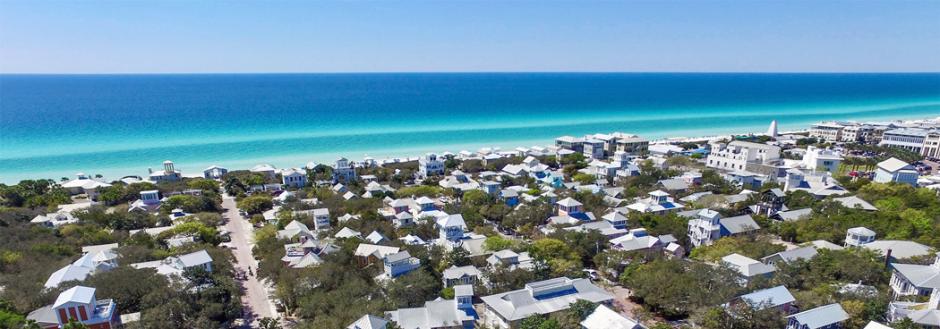 |
| Swiped from seasidefl.com |
The core problem that the New Urbanism addresses is sprawl, from which numerous other evils spring. Sprawl occurs when a metropolitan area develops over a large area, relying on low-density housing developments, located far from places to work, connected by vast networks of highways. Atlanta, Houston and Los Angeles are probably the most famous loci of sprawl, but it's plenty visible in older cities like Chicago, and certainly has occurred albeit on a smaller scale in Cedar Rapids.
 |
| Scottsdale AZ (Wikimedia creative commons) |
The evils of sprawl are, as I said, numerous: traffic congestion and air pollution, highway deaths and injuries, waste of taxpayer dollars, individual spending on transportation, and disinvestment in core cities. The last has meant poverty and marginalization for those unable to follow their better-off neighbors out of urban (and older suburban) ghettos. Society loses from the lack of public spaces or time to spend in them: people have less contact with people different from themselves, including those who live nearby, spending time isolated in their cars, or with similar and like-minded friends ("gated communities of the mind," in Douglas Calthorpe's phrase). Individual rationality is collective irrationality, and then the individuals find themselves on an accelerating hamster wheel with no way to get off.
Addressing these problems requires shifting our policy focus to metropolitan regions and individual neighborhoods. Metropolitan problems need to be handled by metropolitan governments with the ability to make decisions (highways, urban growth and urban service boundaries) in the best interests of the whole region, not just of individual municipalities. Zoning in particular needs to change, allowing for integrated planning, and ditching the current system which require physical separation of different uses and ridiculous amounts of parking while indifferent to how a place looks and operates.
Their most intriguing recommendations have to do with how neighborhoods should look. The "traditional neighborhood" idea common to New Urbanism thought consists of streets that are walkable and human scaled (narrow so they're safe for bicycles and pedestrians, architecturally pleasant), diverse in population, varied in uses, and shaped around public spaces ("centers") that are meaningful and memorable. These centers provide loci for the "everyday and sometimes random casual meetings that foster a sense of community" (Calthorpe and Fulton ch 2). Many places should be reachable in a five-minute walk. Walkable and bikeable streets should support an appropriately-scaled system of public transit (Calthorpe and Fulton ch 9).
Revitalized cities would be able to provide the advantages of "urbanism" without miserable areas of concentrated poverty. People who wanted different kinds of lifestyles would have different options, but without incentives to push ever-outward. More people could get to work, shop, recreation and back home with a reasonable amount of time and effort, without destroying the atmosphere and depleting resources. More contact between people might well bring a greater sense of common purpose and common destiny.
All the authors recognize that there are powerful forces arrayed against attainment of these goals. Wealthy interests are heavily invested in the current system, and individualism is everywhere rampant. Imagining trying to convince Naperville not to sprawl into Will County, or to do some infill, is enough to convince one of the hazards of this project. Then imagine trying to convince Naperville that its destiny is any way tied to that of 63rd Street in Chicago (other than keeping it as far away as possible). The authors are, thankfully, politically realistic, and offer some ideas about how to persuade. (Hester is particular puts a great deal of emphasis on inclusive participation, but they all do to some extent.) They remain convinced that we don't have the resources or the public funds to sustain sprawl, and that communities cannot flourish with so much of their population miserable and marginalized.
In future posts I hope to illustrate some of the specific aspects of the New Urbanism, as well as some of the challenges in making them come alive.
SOURCES

 Calthorpe, Peter, and Fulton,
William. The Regional City: Planning for the End of Sprawl. Washington:
Island, 2001.
Calthorpe, Peter, and Fulton,
William. The Regional City: Planning for the End of Sprawl. Washington:
Island, 2001.
Duany, Andres; Plater-Zyberk,
Elizabeth; and Speck, Jeff. Suburban Nation: The Rise of Sprawl and the
Decline of the American Dream. New York: North Point, 2000.

 Hester, Randolph T. Design
for Ecological Democracy. Cambridge: MIT Press, 2006.
Hester, Randolph T. Design
for Ecological Democracy. Cambridge: MIT Press, 2006.Kelbaugh, Douglas S. Repairing the American Metropolis: Common Place Revisited. Seattle: University of Washington Press, 2002.







No comments:
Post a Comment